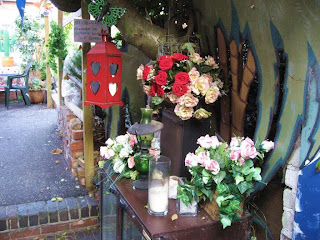
Thursday, 31 July 2008
Algorithmic walking

Let your shoes do the talking

Have a look at this web page which describes some clever technology used to dictate the direction of a walk. Rather than using your senses to determine a route, "I like the look of that", "I wonder where that goes"... these people have modified some roller shoes to automatically and randomly indicate to the wearer which way to travel - have a look at
http://www.xncroft.com/projects/energyshoes.html
An interesting take on the dérive concept.
Tuesday, 29 July 2008
Dry Run
Time: 6.55pm
Route:
View Larger Map
It was the hottest day of the year so far and my starting point was at the corner of Berkeley Avenue and St Saviours Road in Reading, Berkshire at around 7:00pm.
The sun was still warm but lowish in the sky and cast a shadow of a tree on the wall of Woodville Court, a block of modernish flats.

I started the walk by heading up hill up Berkeley Avenue towards the East. There is a little incline up to two bridges that first cross the A33 and then the Kennet Canal. The bridges look like old railway type affairs covered with large rivets with domed tops. A metal plate claims that each bridge was built by E.C & J.Keay Ltd of Birmingham in 1908. The Kennet and Avon canal joins the Thames in Reading but actually travels a long way to the West back up to Bristol.

Now heading down the hill, Katesgrove Primary school is on the left with its playground pretty full of people sitting and chatting with some children running about. This is a public area but I am not sure how to get in. The area if often used by teenagers playing cricket against the walls, some of which are brightly painted.

I headed past the playground and again up hill past Elgar Road and then right into the accurately named Hill Street. Hill Street is one of the strangest roads in Reading for the bottom half has a normal tarmac whilst the top half is bare earth. Why is this so in the centre of Reading, less than 500m from the Oracle and all its good surfaces? Why has this surface been left unfinished? Cars are parked both sides on this earth road and must struggle to hang on in Winter.
I notice that a lot of houses on this road are for let or for sale. Looking now at the Parkers website I see that one is for sale for £199,000, it says: "Located within Reading town centre, This three double bedroom , three storey Victorian mid terrace home has been sympathetically refurbished and retains many period features. The property benefits from no onward chain complications and has accommodation comprising..." It does not mention the mud on the street but still the house looks good and the price is attractive for the town center.
Hill Street is crossed by Francis Street, I have to decide to go left or right, I go left as it is away from home. This part of Francis Street is encased by the ends of the terrace houses from Hill Street and Sherman Road. I walk onto the heavily terraced West Hill where some music is coming from an open upstairs window.

West Hill comes out onto Southampton Street which used to be the main link from the M4 into the town center. I cross Southampton Street and enter the quieter Upper Crown Street which has a no through road sign. Number 18 is being renovated with scaffolding against the front wall, the wall is heavily veiled in trailing plants. I now turn left on to Newark Street towards a block of new looking flats.
At the end of Newark Street, to my surprise, I come out on to London Road (the A4) which is a one way road from the East (in fact London) into the town center. The Seaspray fish and chip shop if located here but sadly there is nowhere to park for passing motorists so it caters, I would guess, for walkers mostly.
I cross back over Southampton Street and start my way back up Berkeley Avenue which I learnt at this point is called Pell Street. I pass the old brick-a-brack store which sells second hand furniture and reclaimed 'stuff' for the purchasing public, the sun is getting very low in the sky now.

I decide that that is enough for this evening and start to make my way home... then I pass a pub that I have never been in, The Claddagh Ring. The pub is on Berkeley Avenue and Elgar Road. On entry an Irish theme quickly reveals itself with some locals sat at the bar and some in the corners of the little room. I buy a pint of Fosters served in a Becks Vier glass for £2.90 and make my way to the back of the bar where there looks to be some sort of yard through a small door. This is the best move of the night. The little yard/terrace is decorated with all manner of things including, strange clocks, plastic flowers, straw hats, cat statues, candles, lamps and some hints to Ireland.

The yard backs on to a small beer garden which is filled with a mix match of garden furniture, a 2m barbecue, a table football table and an inflatable cactus. I take a seat and enjoy my pint. I then enjoy a second pint before declaring an end to my evening's trip.




